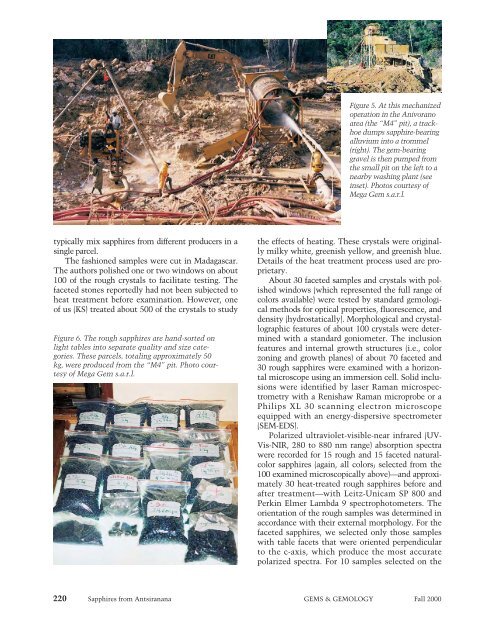Fall 2000 Gems & Gemology - Gemfrance
Fall 2000 Gems & Gemology - Gemfrance
Fall 2000 Gems & Gemology - Gemfrance
Create successful ePaper yourself
Turn your PDF publications into a flip-book with our unique Google optimized e-Paper software.
typically mix sapphires from different producers in a<br />
single parcel.<br />
The fashioned samples were cut in Madagascar.<br />
The authors polished one or two windows on about<br />
100 of the rough crystals to facilitate testing. The<br />
faceted stones reportedly had not been subjected to<br />
heat treatment before examination. However, one<br />
of us (KS) treated about 500 of the crystals to study<br />
Figure 6. The rough sapphires are hand-sorted on<br />
light tables into separate quality and size categories.<br />
These parcels, totaling approximately 50<br />
kg, were produced from the “M4” pit. Photo courtesy<br />
of Mega Gem s.a.r.l.<br />
Figure 5. At this mechanized<br />
operation in the Anivorano<br />
area (the “M4” pit), a trackhoe<br />
dumps sapphire-bearing<br />
alluvium into a trommel<br />
(right). The gem-bearing<br />
gravel is then pumped from<br />
the small pit on the left to a<br />
nearby washing plant (see<br />
inset). Photos courtesy of<br />
Mega Gem s.a.r.l.<br />
the effects of heating. These crystals were originally<br />
milky white, greenish yellow, and greenish blue.<br />
Details of the heat treatment process used are proprietary.<br />
About 30 faceted samples and crystals with polished<br />
windows (which represented the full range of<br />
colors available) were tested by standard gemological<br />
methods for optical properties, fluorescence, and<br />
density (hydrostatically). Morphological and crystallographic<br />
features of about 100 crystals were determined<br />
with a standard goniometer. The inclusion<br />
features and internal growth structures (i.e., color<br />
zoning and growth planes) of about 70 faceted and<br />
30 rough sapphires were examined with a horizontal<br />
microscope using an immersion cell. Solid inclusions<br />
were identified by laser Raman microspectrometry<br />
with a Renishaw Raman microprobe or a<br />
Philips XL 30 scanning electron microscope<br />
equipped with an energy-dispersive spectrometer<br />
(SEM-EDS).<br />
Polarized ultraviolet-visible-near infrared (UV-<br />
Vis-NIR, 280 to 880 nm range) absorption spectra<br />
were recorded for 15 rough and 15 faceted naturalcolor<br />
sapphires (again, all colors; selected from the<br />
100 examined microscopically above)—and approximately<br />
30 heat-treated rough sapphires before and<br />
after treatment—with Leitz-Unicam SP 800 and<br />
Perkin Elmer Lambda 9 spectrophotometers. The<br />
orientation of the rough samples was determined in<br />
accordance with their external morphology. For the<br />
faceted sapphires, we selected only those samples<br />
with table facets that were oriented perpendicular<br />
to the c-axis, which produce the most accurate<br />
polarized spectra. For 10 samples selected on the<br />
220 Sapphires from Antsiranana GEMS & GEMOLOGY <strong>Fall</strong> <strong>2000</strong>


